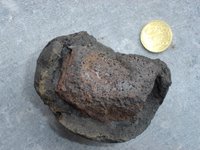VOLCANO-1
vulcanic rock classification, by means of texture, minerals and color.
Sunday, February 12, 2006
Saturday, February 11, 2006
classification of igneous rocks
Classification of igneous rocks
Igneous Rocks have a two-dimensional classification scheme based on chemistry, grain size and texture.
chemistry:
The key to chemical classification in igneous rocks is the amount of Silica (SiO2) in the magma. (Of course people who study this make a much bigger deal out of it! If magmas don't have much silica, their minerals are dominated by magnesium and iron (Fe) - hence the term MAFIC (MA- from the magnesium and FIC from the Fe), or even ULTRAMAFIC for the really silica poor varieties. Silica rich magmas have a mineral named feldspar in them (see book) and are called FELSIC as a result. You will also see the words "acidic" and "basic" used for felsic and mafic respectively and you should be aware that this has nothing to do with pH! One can often tell about how much silica is in a rock just by its color. The more silica, the lighter the color.
grain size:
The main control of grain size is how fast the rock cooled from the molten state. Slow cooling allows bigger crystals to form, and fast cooling makes smaller crystals and even glass (no crystals). So the second dimension of igneous rock classification is whether the rock was formed by cooling on the surface as an extrusive rock. or in the crust as an intusive rock. Magma can either be erupted (extruded) as ash to make pyroclastic rock or as lava to make volcanic rocks.
Texture:
Igneous textures are classified by the presence or absence of crystals, the size of the crystals, and the size and density of vesicles (holes). Check out this page for a nice summary of igneous textures.
Volcanic Rocks:
Volcanic rocks are mainly classified by the amount of silica. There are four main categories with increasing silica: basalt, andesite, dacite and rhyolite.
Intrusive Rocks
Intrusive rocks cool slower and have coarser grain sizes than their extrusive counterparts. The big four of intrusive rocks are with increasing silica: gabbro, diorite, granodiorite, and granite.
Viscosity:
Increasing silica not only makes magmas lighter (in color), but makes them more viscous (stiffer), so the beautiful movies of flowing glowing lava flows from Hawaii are of basaltic lavas with little silica.
Melting temperature:
Increasing silica lowers the melting temperature, so that granites melt at about half the temperature that basalts do.
Water:
Adding water also lowers melting temperature and decreases viscosity. Also, water and other gases make bubbles in the magma, contributing to the explosive power of some eruptions and also leaving holes in the rocks (vesicles).
Melting: While we're on the subject of melting, it is very important to note that each mineral has a different melting temperature, so rocks do not melt all at once, but bit by bit. Thus most magmas have floating bits of crystals in them (phenocrysts
Field classification
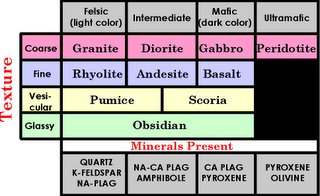
To employ this classification we must first determine the rock's texture. Click HERE if you wish to go to a discussion of igneous rock textures. You might remember we have five basic textures; phaneritic (coarse), aphanitic (fine), vesicular, glassy and fragmental (our classification doesn't bother with the latter because we often term all fragmental igneous rocks tuffs). Examine your rock and determine which textural group it belows to. If it is glassy, vesicular or fragmental you cannot determine mineralogy and hence the name is simply obsidian for a glass, tuff for a fragmental or pumice/scoria for a vesicular rock (the latter are differentiated on the basis or color and size of the vesicles or holes).
For the phaneritic and some aphanitic rocks you must determine the mineralogy. Often it is only necessary to identify one or two key minerals, not all of the minerals in the rock. For instance quartz and potassium feldspar (k-feldspar) are restricted to granites and rhyolites. Amphibole is only abundant in diorite or andesite, although minor amounts can be present in granite. How am I getting these names? Let's take an example. I pick up my first specimen and notice that it is distinctly coarse grained (phaneritic). This means that it must be one of the rocks in the row labeled coarse (i.e., granite, diorite, gabbro or peridotite). I next place the rock under a binocular microscope and identify the minerals plagioclase and pyroxene. I go to the bottom row of the chart (Minerals Present) and look for a match with my mineralogy. I find it in the third column (Ca-play, pyroxene) and read the name (gabbro) from the coarse row on the chart. Pretty simple!! Relax, when you actually begin your igneous rock identification we will walk you through it step by step. But remember to refer to the above classification diagram often as an aid.
IUGS classification
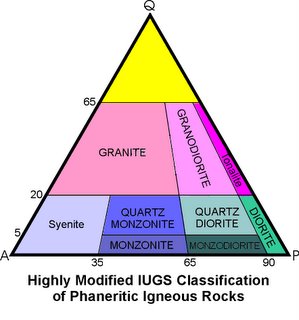
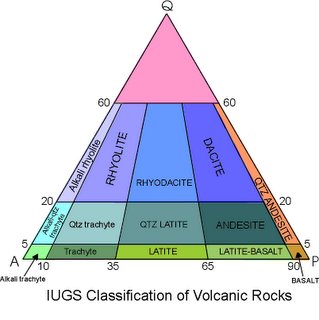
Igneous rocks are classified on the basis of mineralogy, chemistry, and texture. Texture is used to subdivide igneous rocks into two major groups: (1) the plutonic rocks, with mineral grain sizes that are visible to the naked eye, and (2) the volcanic rocks, which are usually too fine-grained or glassy for their mineral composition to be observed without the use of a petrographic microscope. This is largely a genetic classification based on the depth of origin of the rock (volcanic at or near the surface, and plutonic at depth). Remember that porphyritic rocks have spent time in both worlds.
The plotting of rock modes on these triangular diagrams is simpler than it may appear. The three components, Q (quartz) + A (alkali (Na-K) feldspar) + P (plagioclase), are recalculated from the mode to sum to 100 percent. Each component is represented by the corners of the equilateral triangle, the length of whose sides are divided into 100 equal parts. Any composition plotting at a corner, therefore, has a mode of 100 percent of the corresponding component. Any point on the sides of the triangle represents a mode composed of the two adjacent corner components. For example, a rock with 60 percent Q and 40 percent A will plot on the QA side at a location 60 percent of the distance from A to Q. A rock containing all three components will plot within the triangle. Since the sides of the triangle are divided into 100 parts, a rock having a mode of 20 percent Q and 80 percent A + P (in unknown proportions for the moment) will plot on the line that parallels the AP side and lies 20 percent of the distance toward Q from the side AP. If this same rock has 30 percent P and 50 percent A, the rock mode will plot at the intersection of the 20 percent Q line described above, with a line paralleling the QA side at a distance 30 percent toward P from the QA side. The third intersecting line for the point is necessarily the line paralleling the QP side at 50 percent of the distance from the side QP toward A. A rock with 25 percent Q, 35 percent P, and 40 percent A plots in the granite field, whereas one with 25 percent Q, 60 percent P, and 15 percent A plots in the granodiorite field. The latter is close to the average composition of the continental crust of the Earth.
Muscovite
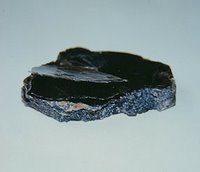

KAl2(Si3Al)O10(OH,F)2
Cleavage: [001] Perfect
Color: White, Gray, Silver white, Brownish white, Greenish white.
Density: 2.77 - 2.88, Average = 2.82
Diaphaniety: Transparent to translucent
Fracture: Brittle - Sectile - Brittle fracture with slightly sectile shavings possible.
Habits: Massive - Lamellar - Distinctly foliated fine-grained forms.,
Foliated - Two dimensional platy forms.,
Micaceous - Platy texture with "flexible" plates.
Hardness: 2-2.5 - Gypsum-Finger Nail
Luminescence: None.
Luster: Vitreous (Glassy)
Streak: white
Olivine
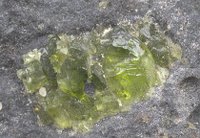
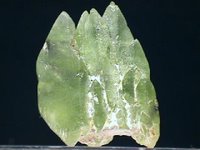
(Mg,Fe)2SiO4
Cleavage: [001] Good, [010] Distinct
Color: Yellowish green, Olive green, Greenish black, Reddish brown.
Density: 3.27 - 3.37, Average = 3.32
Diaphaniety: Transparent to translucent
Fracture: Brittle - Conchoidal - Very brittle fracture producing small, conchoidal fragments.
Habit: Massive - Granular - Common texture observed in granite and other igneous rock.
Hardness: 6.5-7 - Pyrite-Quartz
Luminescence: Non-fluorescent.
Luster: Vitreous (Glassy)
Streak: white
Biotite
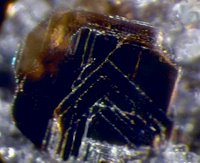
K(Mg,Fe++)3[AlSi3O10(OH,F)2
Cleavage: [001] Perfect
Color: Dark brown, Greenish brown, Blackish brown, Yellow, White. Density: 2.8 - 3.4, Average = 3.09
Diaphaniety: Transparent to translucent to opaque
Fracture: Uneven - Flat surfaces (not cleavage) fractured in an uneven pattern.
Habits: Micaceous - Platy texture with "flexible" plates., Lamellar - Thin laminae producing a lamellar structure., Pseudo Hexagonal - Crystals show a hexagonal outline.
Hardness: 2.5-3 - Finger Nail-Calcite
Luminescence: None.
Luster: Vitreous - Pearly
Streak: gray
Augite

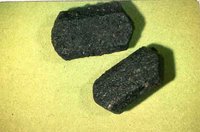

(Ca,Na)(Mg,Fe,Al,Ti)(Si,Al)2O6
Cleavage: [110] Perfect, [010] Indistinct
Color: Brown green, Green, Light brown, Dark brown, Black.
Density: 3.2 - 3.6, Average = 3.4
Diaphaniety: Translucent to opaque
Fracture: Brittle - Conchoidal - Very brittle fracture producing small, conchoidal fragments.
Habits: Massive - Fibrous - Distinctly fibrous fine-grained forms.,
Columnar - Forms columns,
Granular - Generally occurs as anhedral to subhedral crystals in matrix.
Hardness: 5-6.5
Luminescence: Non-fluorescent.
Luster: Vitreous - Resinous
Streak: greenish gray
Leucite

KAlSi2O6
Cleavage: [110] Indistinct
Color: Colorless, Gray, Yellow gray, White.
Density: 2.47
Diaphaniety: Translucent to transparent
Fracture: Brittle - Conchoidal - Very brittle fracture producing small, conchoidal fragments.
Habit: Crystalline - Coarse - Occurs as well-formed coarse sized crystals.
Hardness: 6 - Orthoclase
Luminescence: Non-fluorescent.
Luster: Vitreous (Glassy)
Magnetism: Nonmagnetic
Streak: white
Andesine

(Na,Ca)(Si,Al)4O8
Cleavage: [001] Perfect, [010] Good
Color: Colorless, Gray, Yellow green, White.
Density: 2.66 - 2.68, Average = 2.67
Diaphaniety: Transparent to Subtransparent to translucent
Fracture: Uneven - Flat surfaces (not cleavage) fractured in an uneven pattern.
Habits: Granular - Generally occurs as anhedral to subhedral crystals in matrix.,
Crystalline - Coarse - Occurs as well-formed coarse sized crystals,
Granular - Generally occurs as anhedral to subhedral crystals in matrix.
Hardness: 7 - Quartz
Luminescence: Non-fluorescent.
Luster: Vitreous (Glassy)
Streak: white
Albite
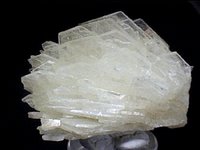
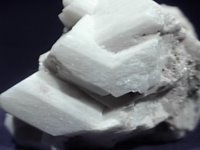
NaAlSi3O8
Cleavage: [001] Perfect, [010] Good
Color: White, Gray, Greenish gray, Bluish green, Gray.
Density: 2.61 - 2.63, Average = 2.62
Diaphaniety: Transparent to translucent to subtranslucent
Fracture: Uneven - Flat surfaces (not cleavage) fractured in an uneven pattern.
Habits: Blocky - Crystal shape tends to be equant (e.g. feldspars),
Striated - Parallel lines on crystal surface or cleavage face.,
Granular -Generally occurs as anhedral to subhedral cryst als in matrix.
Hardness: 7 - Quartz
Luminescence: None.
Luster: Vitreous (Glassy)
Streak: white
Labradorite
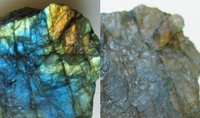
(Ca,Na)(Si,Al)4O8
Cleavage: [001] Perfect, [010] Good, [110] Distinct
Color: Colorless, Gray, Gray white, White, Light green.
Density: 2.68 - 2.71, Average = 2.69
Diaphaniety: Translucent to transparent
Fracture: Uneven - Flat surfaces (not cleavage) fractured in an uneven pattern.
Habits: Granular - Generally occurs as anhedral to subhedral crystals in matrix.,
Crystalline - Coarse - Occurs as well-formed coarse sized crystals.,
Striated - Parallel lines on crystal sur face or cleavage face.
Hardness: 7 - Quartz
Luminescence: Non-fluorescent.
Luster: Vitreous (Glassy)
Streak: white





